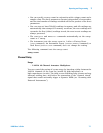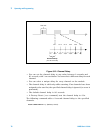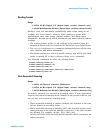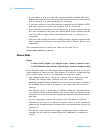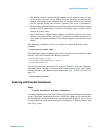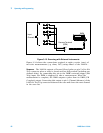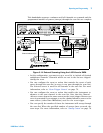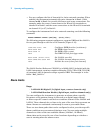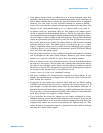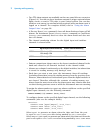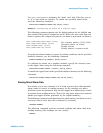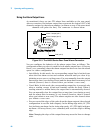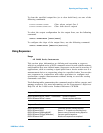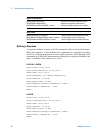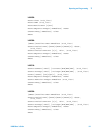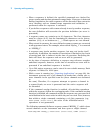Operating and Programming 3
L4400 User’s Guide 85
• If an alarm event occurs on a channel as it is being scanned, then that
channel’s alarm status is stored in instrument memory as the readings are
taken. Each reading that is outside the specified alarm limits is logged in
memory. You can store at least 500,000 readings in memory during
a scan. You can read the contents of instrument memory at any time, even
during a scan. Instrument memory is not cleared when you read it.
• As alarm events are generated, they are also logged in an alarm queue,
which is separate from instrument memory. This is the only place where
non- scanned alarms get logged (alarms generated by the digital modules).
Up to 20 alarms can be logged in the alarm queue. If more than 20 alarm
events are generated, they will be lost (only the first 20 alarms are saved).
Even if the alarm queue is full, the alarm status is still stored in reading
memory during a scan. The alarm queue is cleared by the
*CLS (clear
status) command, when power is cycled, and by reading all of the entries.
A Factory Reset (
*RST command) or instrument preset (SYSTem:PREset)
does not clear the alarm queue.
• You can assign an alarm to any configured channel and multiple channels
can be assigned to the same alarm number. However, you cannot assign
alarms on a specific channel to more than one alarm number.
• When an alarm occurs, the instrument stores relevant information about
the alarm in the queue. This includes the reading that caused the alarm,
the time of day and date of the alarm, and the channel number on which
the alarm occurred. The information stored in the alarm queue is always
in absolute time format and is not affected by the
FORMat:READing:TIME:TYPE command setting.
• You must configure the channel before setting any alarm limits. If you
change the measurement configuration, alarms are turned off and the
limit values are cleared.
• If you plan to use scaling on a channel which will also use Mx+B scaling
(L4450A counter function), be sure to configure the scaling values first. If
you attempt to assign the alarm limits first, the instrument will turn off
alarms and clear the limit values when you enable scaling on that channel.
If you specify a custom measurement label with scaling, it is automatically
used when alarms are logged on that channel.
• If you redefine the scan list, alarms are no longer evaluated on those
channels (during a scan) but the limit values are not cleared. If you decide
to add a channel back to the scan list (without changing the function), the
original limit values are restored and alarms are turned back on. This
makes it easy to temporarily remove a channel from the scan list without
entering the alarm values again.



